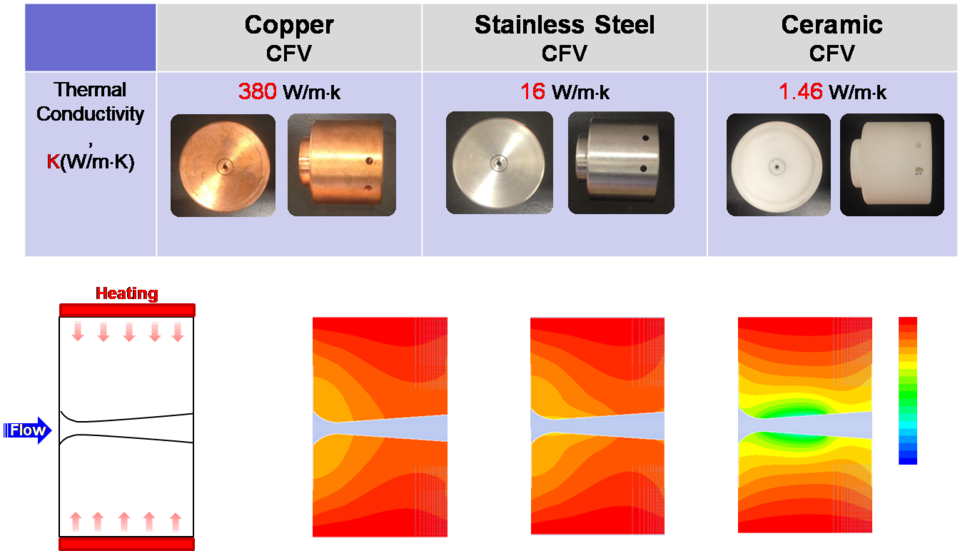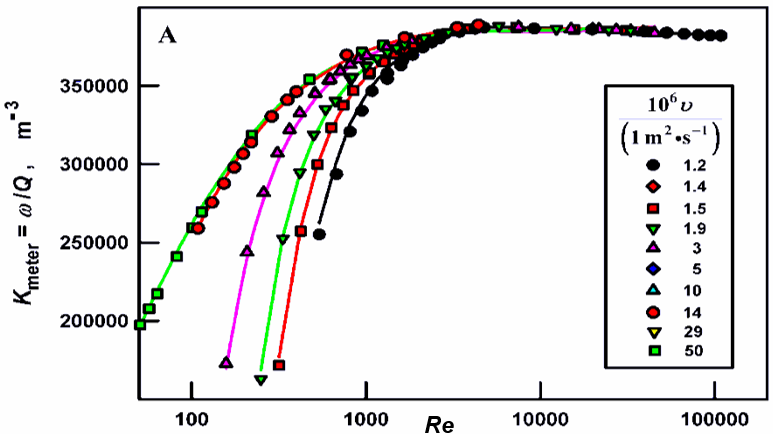Summary
Accurate flow measurements are needed for test fluids, temperatures, pressures, flows, and installation conditions that differ from those used during NIST's calibrations; therefore, we strive to predict the performance of flow meters under a wide range of conditions. To do so, we study the operating principles of a wide range of flow meters. We concentrate on those meters that we use as 1) working standards (meters calibrated by NIST and used by manufacturers or secondary laboratories as reference flow meters), and 2) transfer standards (meters for inter-laboratory comparisons and proficiency tests).
Description
Critical flow venturis (CFVs) are widely used for gas flows of 1 L/min or more, if a significant pressure drop is acceptable.
- Theoretical discharge coefficient (Cd): A calculated value of the discharge coefficient allows 0.3% uncertainty from a CFV from a low uncertainty throat diameter measurement. In Johnson and Wright, 2008, the Fluid Metrology Group used low uncertainty dimensional metrology to show that theoretical Cds agree with experimental Cds within 0.09% for CFVs with throat diameters > 5 mm.
- Species effects: In What is the "Best" Transfer Standard for Gas Flow?, Wright plots the differences in a CFV discharge coefficient for different gases. The largest differences (2%) are due to vibrational relaxation in CO2 as explained in Johnson et al., 2006 and Johnson et al., 2000. Some remaining species effects have been improved by better calculations of the real gas critical flow function (see Wright and Johnson, 2009), and that property is now available in NIST's Standard Reference Database 23 - REFPROP.
- Transient flows: Rapidly changing and pulsatile flows can introduce significant flow errors in gaseous re-fueling and reciprocating compressor applications. The fluid Metrology Group has used CFVs with fast instrumentation (see Wright, 2010 Performance of critical flow venturis under transient conditions) to test coriolis meter response to transient flows.
- Thermal effects: CFVs smaller than 10 mm exhibit sensitivity to the environmental temperature because of the difficulty in measuring the correct temperature of a gas flow and thermal boundary layer effects. The Fluid Metrology Group developed a theoretical explanation for the thermal effects and presented experimental results in Thermal Effects on Critical Flow Venturis, Wright et al. 2015.

Laminar flow meters are often used for flows < 1 L/min.
- In Simple flow meter and viscometer of high accuracy for gases, Berg merged the physical models available in literature to account for Hagen-Poiseiulle, slip, virial, expansion, thermal, and kinetic energy effects.
- The Fluid Metrology Group applied the laminar flow meter model to commercially available meters and demonstrated the improvement over the usually applied models in Calibration of laminar flow meters for process gases Wright et al., 2012.
Turbine flow meters are widely used for liquid flow comparisons.
- Pope et al., 2012 demonstrated that an extended version of the Lee model explained the complex calibration curves obtained when fluid kinematic viscosity is varied between 1 cSt and 50 cSt. Subsequent publications by Pope in 2012 and 2013 show the model works for a wide variety of turbine designs, enabling transition to safer calibration fluids in laboratory flow standards.

Ultrasonic flow meters are used in liquids, natural gas, and smoke stacks.
- The Fluid Metrology Group makes computer simulations of the velocity field in real-world pipe configurations (e.g. downstream of elbows) to understand profile effects on multi-path flow meters, (see Johnson et al., 2013 and Prasad et al., 2013).
- The addition of the Small Scale Stack Simulator will enable experimental research in this field with < 1% uncertainty, (see Johnson et al., 2013).
- The performance of transit time ultrasonic meters in a hot gas flow was explored in the publication Wright, 1998.
Coriolis flow meters are used in liquid and gas flows.
- NIST researchers are studying the effects of temperature on coriolis flow meter performance with the goal of extrapolating room temperature calibrations in water to cryogenic liquid flows (see Costa et al., 2020).
- The NIST Transient Flow Facility was used to research the application of coriolis meters to totalize rapidly changing flows like those found in dispensers of gaseous fuels like hydrogen or methane (see Pope and Wright, 2014).
Pitot tubes are used as air speed sensors and to conduct velocity profiles in liquid flows and smoke stacks.
- In Calibrations of Multi-Hole Pitot Tubes Depend on Turbulence, and NIST's New 3D Airspeed Calibration Rig Addresses Turbulent Flow Measurement Challenges, Shinder et al. showed that flow separation occurring at some tilt angles causes hysteresis in Pitot tube calibration results.
Anemometers
- When anemometers are calibrated in NIST's large, low-turbulence wind tunnel and then used in smaller wind tunnels, their responses to blockage and wall effects may lead to errors. This is a subject of ongoing research.

